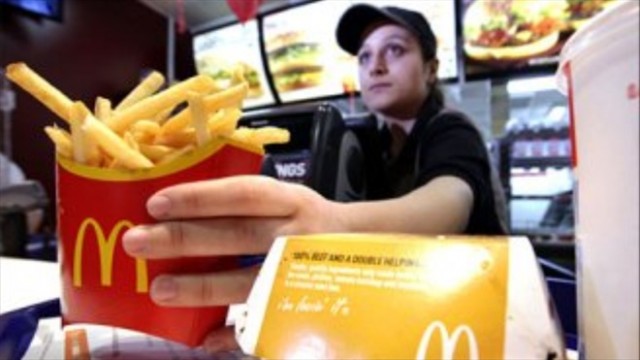Isn’t it strange that so many working people get assistance from their local food banks? The Greater Boston Food Bank, for instance, reports that about one-third of its recipient households have at least one working adult. Isn’t it also strange that many full-time workers get government welfare checks on top of their paychecks? Thousands of Wal-Mart’s $8-an-hour workers, for example, have been known to receive public assistance in the form of TANF, food stamps, Medicaid, affordable housing, and private charity.
There are many explanations for why working people should be in such a fix. The common refrain from leftist circles is that corporations aggressively low-ball their wages for retail and service jobs. Wal-Mart is the prototypical example. Therefore, honest workers are actually turning to public assistance and charity to make ends meet. Now, how do we turn this upside-down economic picture right-side-up?
This may sound counter-intuitive to those on the left, but suppose we just pulled the plug on public assistance for all able-bodied adults. That means no welfare, no food stamps, no affordable housing, no government-run aid of any kind. That also means no food pantries, no clothing drives, no church- or community-run assistance. Then take all those billions of dollars of resources, and instead use this money to tie a “living-wage subsidy” to anyone making a non-living wage. Roughly put, if a Wal-Mart or any other full-time employee makes, say, $8 per hour, the subsidy will kick in until their pay rate is brought up to $12.
Why would this living-wage subsidy (“LWS” for short) be better than the current battery of assistance programs?
- Simplicity
Imagine our current administrative burden — across the entire landscape of public assistance offerings — to verify applicants’ needs, coordinate with service providers (e.g., grocers, landlords, hospitals, etc.), dispense benefits, and continually solicit and process reports from beneficiaries for benefit renewal. Then imagine the ease of administering the LWS: just get a hold of the applicant’s employer and wage income through his or her W-2 stubs, and pay out accordingly. (Self-employed applicants, of course, would need to provide additional proof of income.) - Empowerment
Currently, there is a Catch-22 in getting off welfare: entry level wages for many jobs are so low, that it is a better deal to stay on the couch. However, with the LWS, beneficiaries are given an incentive to maintain full-time employment in order to receive a generous government subsidy. Suddenly, just sitting at home and collecting a monthly welfare check is no longer attractive when one can get a 30-50% bonus on top of the market rate for low-wage work. Second, a person receives this money not because he or she failed to attain housing or food or health care, but because he succeeded in holding down a regular job to make an honest day’s pay. And its incentivizing properties blow away the Earned Income Tax Credit, which only pays a poor family between a few hundred and a few thousand bucks annually. - Realism
The current welfare system thrives on telling horror stories to guilt tax-payers into continuing food stamps, housing subsidies, and free health care for our “poor” neighbors. The liberal sect of American politics loves to play “the poor card”, citing examples of struggling moms who have to choose between heat for the home and food for the fridge. But very few people take on the root causes of these terrible situations. With the LWS, since we, the tax-payers, are giving cash compensation to people just for working like the rest of us, they’ll quickly start to ask: “Why are we picking up the tab so they can afford the cost of food, shelter, clothing, and health care? Can’t their profitable employers afford to pay them a living wage? And if so, then aren’t we the tax-payers really giving these businesses a free ride?”
And therein lies the absurdity that is the essence of our charity monstrosity. In essence, all of this welfare and charity is doing is shoring up what businesses in a capitalist marketplace are not paying out to their hard-working employees. In this instance, capitalism fails to adequately compensate the lowest rung of the labor force. And by “adequate”, I mean enough wealth to cover the cost of food, housing, clothing, and health care. And so, we the taxpayers dig in our own pockets to cover the rest. Meanwhile, big businesses shell out outrageous sums to their CEOs and upper-management.
Switching to the LWS approach may help policy-makers fully grasp the need to provide a minimum wage to ensure that businesses cannot race to the bottom and shirk their responsibility to fair pay for their lowest-paid employees. As our nation’s Wal-Marts transform into Costcos, we can ditch the living-wage subsidy and the welfare state entirely.


